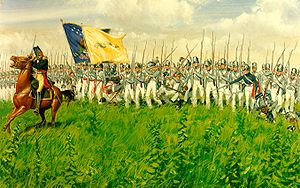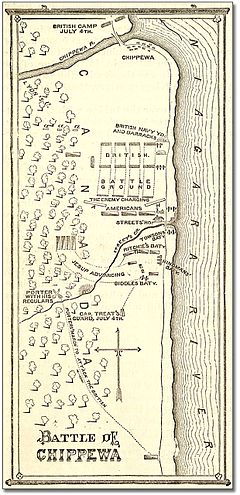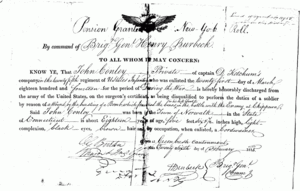- Battle of Chippawa
-
Coordinates: 43°03′08″N 79°01′29″W / 43.052127°N 79.024720°W
Battle of Chippawa Part of the War of 1812 
Winfield Scott leads his infantry brigade forward.Date July 5, 1814 Location Chippawa, Upper Canada (present-day Ontario) Result American victory Belligerents  Great Britain
Great Britain United States
United StatesCommanders and leaders Phineas Riall Jacob Brown
Winfield Scott
Peter Porter[1]Strength 2,100 3,500 Casualties and losses 108 dead
319 wounded
75 wounded prisoners
15 captured
18 missing[2][3][4][5][6]60 killed
249 wounded
19 missing[7]- Queenston Heights
- Frenchman's Creek
- Fort George
- Stoney Creek
- Beaver Dams
- Black Rock
- Fort Niagara
- Buffalo
- Port Dover
- 1st Fort Erie
- Chippawa
- Lundy's Lane
- 2nd Fort Erie
- Cook's Mills
The Battle of Chippawa (sometimes incorrectly spelled Chippewa) was a victory for the United States Army in the War of 1812, during an invasion of Upper Canada along the Niagara River on July 5, 1814.[8]
Contents
Background
In early 1814, it was clear that Napoleon would soon be defeated in Europe, and seasoned British veteran soldiers from the Peninsular War would be redeployed to Canada. The United States Secretary of War, John Armstrong, was eager to win a victory in Canada before British reinforcements arrived there.
Major General Jacob Brown was ordered to form the Left Division of the Army of the North. Armstrong intended him to mount an attack on Kingston, the main British base on Lake Ontario, with a diversion by militia across the Niagara River to distract the British. He had however drawn up alternate orders for a major attack across the Niagara, possibly as a contingency plan, but probably to mislead the British through deliberate leaks.[9] Brown considered that he was being presented with two alternate plans, and was free to choose between them. Although Brigadier General Edmund P. Gaines tried to persuade Brown to make the attack on Kingston, it proved impossible for Brown to gain any cooperation from Commodore Isaac Chauncey (commanding the American naval squadron based at Sackett's Harbor, New York) which was essential for any such attack. Chauncey was waiting for new ships to be completed and refused to make any move before the middle of July. Brown therefore made the attack across the Niagara into the main effort.[9]
Scott's Camp of Instruction
Armstrong had also directed that two "Camps of Instruction" be set up, to improve the standards of the regular units of the United States Army. One was at Plattsburgh, New York, under Brigadier General George Izard. The other was at Buffalo, New York, near the head of the Niagara River, under Brigadier General Winfield Scott[10]
At Buffalo, Scott instituted a major training programme. He drilled his troops for ten hours every day, using the 1791 Manual of the French Revolutionary Army. (Prior to this, various American regiments had been using a variety of different manuals, making it difficult to manoeuvre any large American force). Scott also purged his units of any remaining inefficient officers who had gained their appointments through political influence rather than experience or merit, and he insisted on proper camp discipline including sanitary arrangements. This reduced the wastage from dysentery and other enteric diseases which had been heavy in previous campaigns.[11]
There was only one major deficiency; Scott had been unable to obtain enough regulation blue uniforms for his men. Although they had been manufactured and sent to the northern theater, they had been diverted to Plattsburgh and Sackets Harbor. The United States Army's Commissary General, Callender Irvine, hastily ordered 2,000 uniforms to be made and despatched to Buffalo for Scott's other units, but because there was insufficient blue cloth, short jackets (roundabouts) of grey cloth were used instead.[11] When Scott received the grey roundabouts, he gathered up the blue coatees belonging to his Brigade and gave them to the 21st US Infantry (one of the units in the Brigade of Brigadier General Eleazer Wheelock Ripley), because "the black coatees of the 21st are a discrace to the uniform and soldier of the army of the United States" (G.O. 16, Winfield Scott, May 24, 1814).[non-primary source needed]
Niagara campaign
By early July, Brown's division was massed at the Niagara, in accordance with Armstrong's alternate orders. Without cooperation from Chauncey, a direct attack on Fort George at the mouth of the Niagara was impossible. Nor was it possible to land large numbers of troops on the southern side of the Niagara Peninsula and advance on Burlington to cut off the British on the Niagara River, because the American squadron on Lake Erie (and the regular troops at Detroit) had been diverted to attempt the recapture of Fort Mackinac on Lake Huron.[12] Armstrong suggested that Brown should therefore capture and hold Fort Erie, opposite Buffalo, while waiting for Chauncey to ready his squadron. Brown assented, but was prepared to push much further than the immediate vicinity of Fort Erie.[12]
On July 3, Brown's army, consisting of the regular brigades commanded by Scott (with 1,377 men) and Brigadier General Eleazar Wheelock Ripley (with 1,082 men), and four companies of artillery numbering 327 men under Major Jacob Hindman,[12] easily surrounded and captured Fort Erie which was defended only by two weak companies under Major Thomas Buck. After a brigade of 753 volunteers from the militia under Brigadier General Peter B. Porter, together with 600 Iroquois, arrived on July 4, Scott began advancing north along the portage road alongside the Niagara River. A British covering force under Lieutenant Colonel Thomas Pearson was easily driven back before they could destroy any of the bridges or block the road with fallen trees.[13]
Late in the day, Scott encountered British defences on the far bank of Chippawa Creek, near the town of Chippawa. After a brief exchange of artillery fire, Scott withdrew a few miles to Street's Creek. Here he planned to give his troops a belated Fourth of July parade the next day, while Brown manoeuvred other units to cross the Chippawa upstream.[14]
Opposed to Scott was the Right Division of the British Army in Upper Canada, under Major General Phineas Riall. Riall believed that Fort Erie was still holding out, and the Americans would therefore have detached large numbers of troops to mask it, leaving only 2,000 men to face his division. He may also have believed that his opponents were militia but was comparatively new to command in Canada and relied on information from Lieutenant Colonel John Harvey, the Deputy Adjutant General for the forces in Upper Canada, that even the United States regulars were of poor quality.[15] Riall determined to cross the Chippawa River and mount an attack to drive the Americans back across the Niagara and relieve Fort Erie.
Battle
Early on July 5, British light infantry, militia and Indians crossed the Chippawa ahead of Riall's main body and began sniping at Scott's outposts from the woods to their west. (Some of them nearly captured Scott, who was having breakfast in a farmhouse.)[13] Brown ordered Porter's brigade and Indians to clear the woods. They did so, but they met Riall's advancing regulars and hastily retreated.
Scott was already advancing from Street's Creek. His artillery (Captain Nathaniel Towson's company, with three 12-pounder guns) deployed on the portage road and opened fire. Riall's own guns (two light 24-pounder guns and a 5.5-inch howitzer) attempted to reply, but Towson's guns destroyed an ammunition wagon and put most of the British guns out of action.[16]
Meanwhile, Scott's troops deployed into line with the 25th U.S. Infantry on the left near the woods, the 11th U.S. Infantry and 9th U.S. Infantry in the centre and the 22nd U.S. Infantry on the right with Towson's guns. At first, Riall was under the impression that the American line was composed of grey-clad militia troops, whom the professional British soldiers held in much contempt. He expected the poorly trained soldiers to fall back in disarray after the first few volleys. As the American line continued to hold steady under British artillery fire, Riall realized his error and supposedly exclaimed his famous phrase "Those are regulars, by God!"[16] (Scott appears to be the only source for Riall's utterance; there is no record of it in any British source.)
The British infantry, with the 1/1st (Royal Scots) Foot and the 100th Foot leading and the 1/8th (King's) Foot in reserve, were advancing very awkwardly and becoming bunched and disordered, because Riall had formed them into line for an advance over uneven ground with some very long grass instead of keeping them in column, in which they could have advanced more rapidly. Advancing in line meant that Riall's troops moved more slowly and were under fire from the American artillery for longer. The only benefit of using the line formation instead of column was that it increased firepower, yet Riall sacrificed even this advantage by ordering his infantry to fire only one volley before closing with the bayonet.[17] As the redcoats of the 1/1st and 100th Regiments lumbered forward, their own artillery had to stop firing in order to avoid hitting them. Meanwhile, the American gunners switched from firing roundshot to firing canister, with lethal consequences for the British infantry. Once the opposing lines had closed to less than 100 yards apart, Scott advanced his wings, forming his brigade into a "U" shape which allowed his flanking units to catch Riall's advancing troops in a heavy crossfire.[16]
Both lines stood and fired repeated volleys; after 25 minutes of this pounding Riall, his own coat pierced by a bullet, ordered a withdrawal. The 1/8th, which had been moving to the right of the other two regiments, formed line to cover their retreat. As they in turn fell back, three British 6-pounder guns came into action to cover their withdrawal, with two more 6-pounders firing from the entrenchments north of the Chippawa.[18] Scott halted his brigade, although some of Porter's Iroquois pursued the British almost to the Chippawa.
Casualties
The American official casualty return stated the loss as 60 killed, 249 wounded and 19 missing.[7]
British losses had been heavy; the 100th Regiment, which held the center, was reduced to ...one Captain & 3 subalterns doing duty, with 250 effective men.[19] The official casualty return gave 148 killed, 321 wounded and 46 missing.[2] However, 20th Century research by Canadian archivist Douglas Hendry[3] has demonstrated that the British casualty return for Chippawa marked down many men as killed who had in fact been captured, and that of 136 British regulars who were supposed to have been killed, only 74 actually died. The official return gave 12 Canadian militiamen killed but Donald Graves has determined that 18 actually died.[4] A U.S. Army document signed by Assistant Inspector-General Azariah Horne states the Americans had captured 3 officers and 72 "rank and file" of the British regulars who were wounded and 9 British regulars, 1 "captain of the Indians", 1 Indian chief and 4 Indian warriors who were not wounded.[5] Two British officers, Captains Bird and Wilson, appear in the official casualty list in the "wounded" category with additional information that they have also been taken prisoner.[6] The actual British loss at Chippawa therefore appears to have been 74 regulars, 18 Canadian Militiamen and 16 Indian warriors killed; 303 British regulars (not including Captains Bird and Wilson, who come under the 'wounded prisoners' category), 16 Canadian Militiamen and an unknown number of Indian warriors wounded; 75 British regulars (including Captains Bird and Wilson) wounded and captured by the Americans; 9 British regulars, one officer of the British Indian Department and 5 Indian warriors taken prisoner unwounded. A further 9 British soldiers and 9 Canadian Militiamen appear to have deserted. This gives a grand total of 108 killed, 319 wounded, 75 wounded prisoners, 15 unwounded prisoners and 18 missing.
A curious feature of the British casualty list is that the 1st Battalion, 1st (Royal Scots) Regiment was officially a Scottish unit, yet out of the 36 enlisted men of the battalion who were killed at Chippawa and whose nationality has been identified in the regimental records, 20 were Irish, 8 were English, one had "the Army" as his nationality and only 7 were Scottish.[20]
Aftermath
Two days after the battle, Brown completed his original intended manoeuvre and crossed the Chippawa upstream of Riall's defences, forcing the British to fall back to Fort George. It was not possible to attack this fortified British position because Commodore Chauncey was still failing to support the American army on the Niagara peninsula. No reinforcements or siege artillery could be brought to Brown's army. At the same time, the British were able to rush reinforcements to the Niagara front and soon became too strong for Brown to risk a direct attack. Eventually, a series of feints and manoeuvres led to the Battle of Lundy's Lane a few weeks later.[21]
Legacy
The battle of Chippawa, and the subsequent Battle of Lundy's Lane, proved that American regular units could hold their own against British regulars if properly trained and well led. It is generally considered that Riall, although misled as to the strength of the American forces and their quality[14] advanced overconfidently, and his mistaken tactics led to the heavy British casualties.
The 25th Infantry was later combined with the 27th, 29th and 37th Infantry Regiments to form the 6th Infantry Regiment. The 6th Infantry's motto is "Regulars, by God" from this battle.
The Corps of Cadets of the United States Military Academy at West Point wear grey parade uniforms, but the assertion that they were adopted in commemoration of Scott’s troops at Chippawa appears to be a legend. The reasons given in 1816 for its selection were simply that it wore well and was considerably cheaper than the blue one.[citation needed]
The site is preserved in the Chippawa Battlefield Park, a unit of the Niagara Parks Commission, with a battle monument and interpretive plaques south of Niagara Falls in the town of Chippawa, Ontario. The site of the battle was designated a National Historic Site of Canada in 1921.[22][23]
Notes
- ^ Graves,Donald E.. The Battle of Lundy's Lane on the Niagara in 1814. Baltimore, Maryland: The Nautical & Aviation Publishing, 1993. pages 64-66
- ^ a b Wood, p. 119
- ^ a b Hendry, Douglas, British Casualties Suffered at Chippawa, 5 July 1814. Ottawa: unpublished research report, Directorate of History, Department of National Defense, Canada, December 1991. Hendry's findings appear in Graves, Red Coats and Grey Jackets, referred to on Page 135–136 and given in detail in Appendix E, pp. 176-178
- ^ a b Graves, pp. 178-179. Although Graves gives a list of 21 Canadian militiamen killed, three of the names (John Thompson, Timothy Skinner and Stephen Peer) appear twice on the list, making 18 the correct total
- ^ a b Cruikshank, p. 42
- ^ a b Wood, p. 118
- ^ a b Cruikshank, p. 43
- ^ Red Coats & Grey Jackets, The Battle of Chippawa, By Donald E. Graves
- ^ a b Elting, pp.178–179
- ^ Elting, p.179
- ^ a b Elting, p.180
- ^ a b c Elting, p.182
- ^ a b Elting, p.185
- ^ a b Hitsman, p.221
- ^ Hitsman, p.218
- ^ a b c Elting, p.186
- ^ Cruikshank, p. 48., "orders were to give one volley at a distance and immediately charge"
- ^ Elting, p.187
- ^ Hitmsman, p.224
- ^ Graves, pp. 176-177
- ^ Hitsman, pp.223–226
- ^ Battle of Chippawa, Directory of Designations of National Historic Significance of Canada
- ^ Battle of Chippawa, National Register of Historic Places
Sources
- Cruikshank, Ernest A. (1971). A Documentary History of the Campaigns on the Niagara Frontier in the Year 1814. New York: Arno Press Inc.. ISBN 0-405-02838-5.
- Elting, John R. Amateurs to Arms:A military history of the war of 1812. New York: Da Capo Press. ISBN 0-306-80653-3.
- Graves, Donald E.. Red Coats & Grey Jackets: The Battle of Chippawa. Toronto & Oxford: Dundurn Press. ISBN 1-55002-210-5.
- Graves, Donald E.. The Battle of Lundy's Lane on the Niagara in 1814. Baltimore, Maryland: The Nautical & Aviation Publishing. ISBN 1-877853-22-4.
- Hitsman, J. Mackay; Donald E. Graves. The Incredible War of 1812. Toronto: Robin Brass Studio. ISBN 1-896941-13-3.
- Latimer, Jon. 1812: War with America. Cambridge, MA: Belknap/Harvard University Press. ISBN 0-674-02584-9.
- Wood, William (1968). Select British Documents of the Canadian War of 1812. Volume III, Part 1. New York: Greenwood Press.
 National Historic Sites of Canada by location
National Historic Sites of Canada by locationProvinces Territories Northwest Territories · Nunavut · YukonOther countries FranceCategories:- 1814 in Canada
- Battles of the War of 1812
- National Historic Sites in Ontario
Wikimedia Foundation. 2010.


